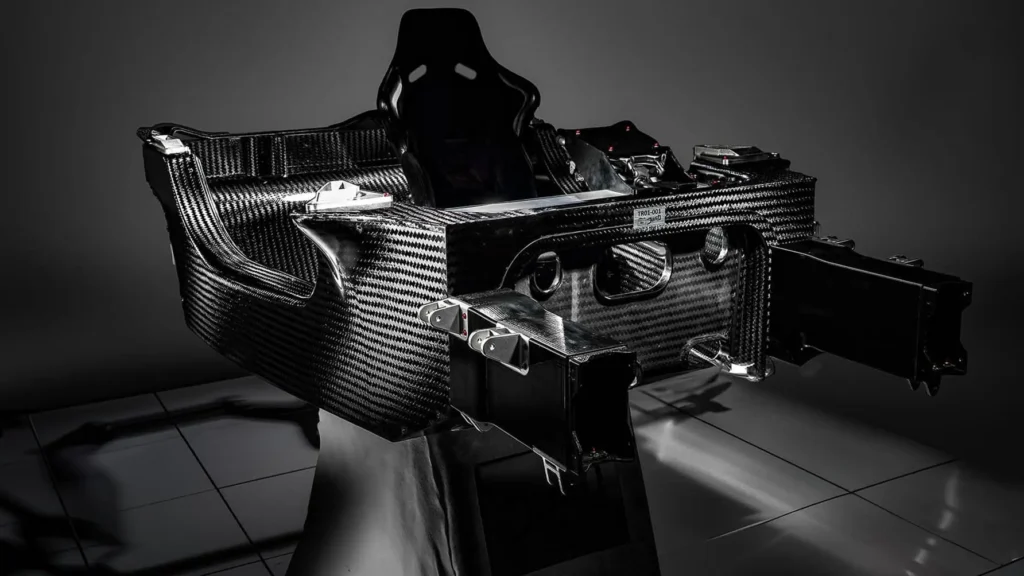With traditional hand layup facilities, Dash-CAE specializes in the engineering, design, and manufacturing of race car components and even entire vehicles. Now, the UK-based firm has introduced a new product, the TR01, a standard carbon fiber monocoque chassis for performance road vehicles. This is a unique development, as most parts a company like Dash would make are custom-designed or short run items. More than that, the manufacture and sale of an entire carbon fiber chassis as a standardized product is not even heard of in vehicle production. Dash has therefore made a bold step by offering a complete composite chassis at $38,000.
Dash has crafted Le Mans LMP cars, prototypes, and carbon fiber bodies for Moto GP in the past, as well as made tooling for various components. 3D printing is also extensively employed within the firm, which relies on Stratasys F900 PRO, F250mc, and F400 machines to create parts, particularly for tooling purposes. It’s unclear to what extent 3D printing has been used in the construction of the chassis, and I believe it would be incorrect to label it as a 3D-printed chassis since the majority of the components are likely made using traditional methods. However, considering Dash-CAE’s extensive experience with 3D printing for tooling, as well as their comprehensive expertise in creating carbon monocoque chassis for motorsport and F1 in particular, some 3D printing has probably been deployed in this project
A carbon fiber monocoque chassis is a fully load-bearing body, using carbon fiber or carbon fiber reinforced plastic to make a strong “tub” for the driver. These tubs, often with a honeycomb center sandwiched between composite material layers, have probably saved lives. The material used in monocoques is often woven from aramid or other fibers and then encased in a thermoset substance. This is typically autoclaved to promote structural integrity, eliminate voids, and enhance performance. While the resulting part is strong and lightweight, it’s labor-intensive to produce, environmentally taxing, and challenging to recycle. Monocoques serve to protect drivers, and simultaneously reduce weight. This often leads to significant changes in the vehicle’s speed, handling, and fuel efficiency.
From a design perspective, the approach shifts from creating a robust and large passenger compartment, or engineering the entire car body to absorb impacts, to crafting a compact escape pod for the driver. It’s analogous to protecting only the safe room in a house instead of the entire structure. This approach uses less weight and material than traditional designs, allowing engineers to focus more on aspects like speed and cornering ability.
“The TR01 chassis opens new possibilities for niche automotive manufacturers, and larger international OEMs by offering an affordable, versatile, lightweight, and high-stiffness carbon monocoque chassis. These programs are often incredibly expensive and the ability to use a production carbon monocoque is a huge time and cost saving, without compromising performance. Our commitment to innovation and engineering excellence makes the TR01 an industry-disrupting solution that challenges traditional carbon chassis production and makes high-performance monocoques far more accessible,” said Dash-CAE CEO Tim Robathan.
Entering the car market is daunting. Costs are staggering and constantly piling up. Success with firms like Koenigsegg or other new and niche entrants is elusive. The TR01 is part of a larger trend to democratize vehicle manufacturing. The TR01 could be a head start for a new electric vehicle at an auto manufacturer, and much more. It could be a simple way to shave some weeks off a concept car, make creating your own unique sports car more affordable, or empower university teams to innovate lightweight vehicles more quickly on tight budgets. It could also revolutionize some racing classes, or, most inspiringly, lead to more companies starting cutting-edge new vehicles. We’re also entering a special era for motorsport with F1 budget caps affecting many suppliers and supply chains. In this light, the release of the TR01 makes a lot of sense.
Access to motorsport engineering enables low volume car manufacturers to get started. A few years ago, we wrote about a new era for car manufacturers and coach building. With electrification, competitiveness, and the availability of engineering and manufacturing, we may yet see a return to a coach building era. This harkens back to when manufacturers made drivetrains, while coach builders added custom bodywork to engines and chassis components. Similar developments are visible in E-bikes, where almost anything can be outsourced.
Modern supercars, however, burn and crumble like Roman Candles in a crash. While the passengers may walk away, the car is often totaled. Something that would severely dent your Twingo or Ford Truck will make a Aventador go up like a molotov cocktail. Part of this is the material composition; carbon monocoque cars have a lot of flammable plastic. These cars are designed for speed, not reliability, which increases risks.
But does this mean the carbon monocoque is dangerous? Far from it. It’s a very safe design, but the usage around these cars is higher risk compared to typical vehicles. For niche carmakers, a chassis like the TR01 could be very helpful, being designed for electric or combustion cars, and adaptable to many configurations. The price seems very affordable, and such a chassis could speed up development, allowing focus on drivetrain or engine.
A 3D printed chassis like this can not be far off, particularly given the growth of the large-format additive manufacturing market and the funding that’s going into companies like Divergent. Something like 3D printed chassis would greatly accelerate the development of 3D printing in the automotive world. That could be done while still talking to relatively small and fast companies that could really innovate with 3D printed components through disrupting the automotive market.
